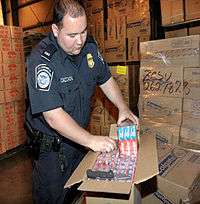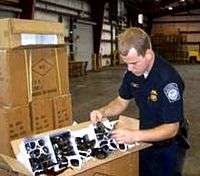Brand piracy
Brand piracy is the act of naming a product in a manner which can result in confusion with other better known brands. According to author Robert Tönnis The term brand piracy is unauthorized usage of protected brand names, labels, designs or description of trade.[1] Annika Kristin states "brand Piracy is considered to be the premeditated use of registered trademark, its name, its tradename or the packaging and presentation of its products".[2] It is a major loss to MNE's around the world as it causes a loss of revenue and image of the brand.[3]


Tönnis describes the consequence of brand piracy as the consumption of fake, untested and poor quality goods by consumers.[1] This can damage the reputation of brands and even result in damage to people's health.[2] In 2012 the CBP promised to protect the economy, the people of the USA and their national security "against harm from counterfeit and pirated goods".[4]
Examples
Examples for imitation and counterfeiting of branded products have been noted as early as 1912.[5]
- Louis Vuitton has had to fight for its brand image after consumers lost interest in it due to the availability of cheap counterfeits.[1]
- Forged Rolex watches can be purchased for a fraction of the original's price in many places of the world.[3]
- In Mexico Cartier has had to fight the piracy of its own brand.[6]
- Benetton, Levi Strauss & Co. and Lacoste have all been victims of counterfeiting in which the label has been altered of an obviously inferior product.[7]
- Examples of Coalgate (as against Colgate) and Del Mundo (instead of Del Monte) fall into the category of counterfeiting under piracy where the product is different but the trademark looks the same.[7]
- The music industry claims that brand piracy causes a loss of USD 4.6 Billion in market share alone. It also states that 7 out of 10 CD's sold around the world are pirated.[7]
Consequences
- Loss of revenue of billions of dollars for the original manufacturers.[3]
- Damage to the reputation of the authentic products and their manufacturers.[8]
- It acts as a barrier to the entry of trademark owners to those markets where their brands are pirated.[2]
- It closes off competition as competitors first get attracted by the high price margin being enjoyed by the original and then have to wage a price war against low price counterfeiters.[9]
Over the last decade, the counterfeiting and piracy phenomenon has risen to very dangerous dimensions and has become one of the most devastating problems facing world business.
Strategies for handling brand piracy
While some experts suggest the company to go the extremes of punishing the counterfeiter,[9] others also suggest takeover or franchisee agreements with them.[9] Some other authors suggest web based web crawlers that can identify and delete any promotional material that infringes with the product of the company.[11] Some authors suggest recourse to legal action and a study of legal protections available in those markets where Piracy is prevalent.[12] Since 1977 obvious plagiarism in regards to established design is also exposed in public by awarding the negative prize Plagiarius. [13] [14] [15] [16]
Further reading
- "Brand Piracy," The Concise Blackwell Encyclopedia of Management, Cary Lynn Cooper and Chris Argyris, p. 48
References
- 1 2 3 Robert Tönnis (July 2007). International Branding - An Internationalization Approach on the Marketing Level. GRIN Verlag. pp. 14–. ISBN 978-3-638-68096-7. Retrieved 18 February 2012.
- 1 2 3 Annika Kristin Baiker (October 2007). Fighting Brand Counterfeiting in E-commerce: Nike as an Example. GRIN Verlag. pp. 35–. ISBN 978-3-638-81102-6. Retrieved 18 February 2012.
- 1 2 3 Cary L. Cooper; Chris Argyris (1998). The concise Blackwell encyclopedia of management. Wiley-Blackwell. pp. 48–. ISBN 978-0-631-20911-9. Retrieved 18 February 2012.
- ↑ "The men and women of CBP protect our nation's economy, the safety of its people, and our national security against harm from counterfeit and pirated goods.". Retrieved 2012-05-07.
- ↑ The Northwestern miller. Miller Pub. Co. 1912. Retrieved 19 February 2012.
- ↑ David E. Gumpert (April 1985). The marketing renaissance. Wiley. p. 117. ISBN 978-0-471-81352-1. Retrieved 18 February 2012.
- 1 2 3 Isobel Doole; Robin Lowe (2008). International marketing strategy: analysis, development and implementation. Cengage Learning EMEA. p. 289. ISBN 978-1-84480-763-5. Retrieved 18 February 2012.
- ↑ "brand piracy is a serious crime and is assuming ever more threatening proportions. It damages the reputation of the brand as well as companies". Retrieved 2012-12-30.
- 1 2 3 Hollensen (1 September 2009). Global Marketing, 4/E. Pearson Education. pp. 472–. ISBN 978-81-317-2814-7. Retrieved 18 February 2012.
- ↑ "http://ec.europa.eu/internal_market/iprenforcement/index_en.htm". European Commission: Enforcement of intellectual property rights. External link in
|title=(help); - ↑ Philip Kotler (1972). Marketing - Management. Pearson Education. pp. 1–. ISBN 978-81-317-1683-0. Retrieved 18 February 2012.
- ↑ John O'Connell (1 February 1999). The Blackwell encyclopedic dictionary of international management. Wiley-Blackwell. pp. 30–. ISBN 978-0-631-21081-8. Retrieved 19 February 2012.
- ↑ "Initiated already back in 1977 by Prof. Rido Busse, the negative award "Plagiarius" serves to inform the public about the problem of fakes and plagiarisms and the negative impacts they have". Retrieved 2013-02-27.
- ↑ "The annual Plagiarius Awards call attention to the most flagrant product imitations and raise awareness about the dangers of piracy". Retrieved 2008-02-08.
- ↑ "Plagiarius 2011: negative award for the Chinese copy of the Hansgrohe Focus S mixer". Retrieved 2011-02-16.
- ↑ "Countering idea theft: Forger of the AC Schnitzer Type V Wheel Wins Negative "Plagiarius" Prize". Retrieved 2012-02-10.
External links
- China's got RedBerry, by Geoffrey York and Simon Avery, The Globe and Mail, April 11, 2006.
- Brand Protection Recent Cases On Brand "Piracy", October 2004.
- International Authentication Association
- International Hologram Manufacturers Association